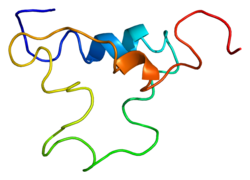Insulin-like growth factor 1 (IGF-1), also called somatomedin C, is a hormone similar in molecular structure to insulin which plays an important role in childhood growth, and has anabolic effects in adults. [5] In the 1950s IGF-1 was called "sulfation factor" because it stimulated sulfation of cartilage in vitro, [6] and in the 1970s due to its effects it was termed "nonsuppressible insulin-like activity" (NSILA). [7]
IGF-1 is a protein that in humans is encoded by the IGF1 gene. [8] [9] IGF-1 consists of 70 amino acids in a single chain with three intramolecular disulfide bridges. IGF-1 has a molecular weight of 7,649 daltons. [10] In dogs, an ancient mutation in IGF1 is the primary cause of the toy phenotype. [11]
IGF-1 is produced primarily by the liver. Production is stimulated by growth hormone (GH). Most of IGF-1 is bound to one of 6 binding proteins (IGF-BP). IGFBP-1 is regulated by insulin. IGF-1 is produced throughout life; the highest rates of IGF-1 production occur during the pubertal growth spurt. [12] The lowest levels occur in infancy and old age. [13] [14]
Low IGF-1 levels are associated with cardiovascular disease, while high IGF-1 levels are associated with cancer. Mid-range IGF-1 levels are associated with the lowest mortality.
A synthetic analog of IGF-1, mecasermin, is used for the treatment of growth failure in children with severe IGF-1 deficiency. [15] Cyclic glycine-proline (cGP) is a metabolite of hormone insulin-like growth factor-1 (IGF-1). It has a cyclic structure, lipophilic nature, and is enzymatically stable which makes it a more favourable candidate for manipulating the binding-release process between IGF-1 and its binding protein, thereby normalising IGF-1 function. [16]
























